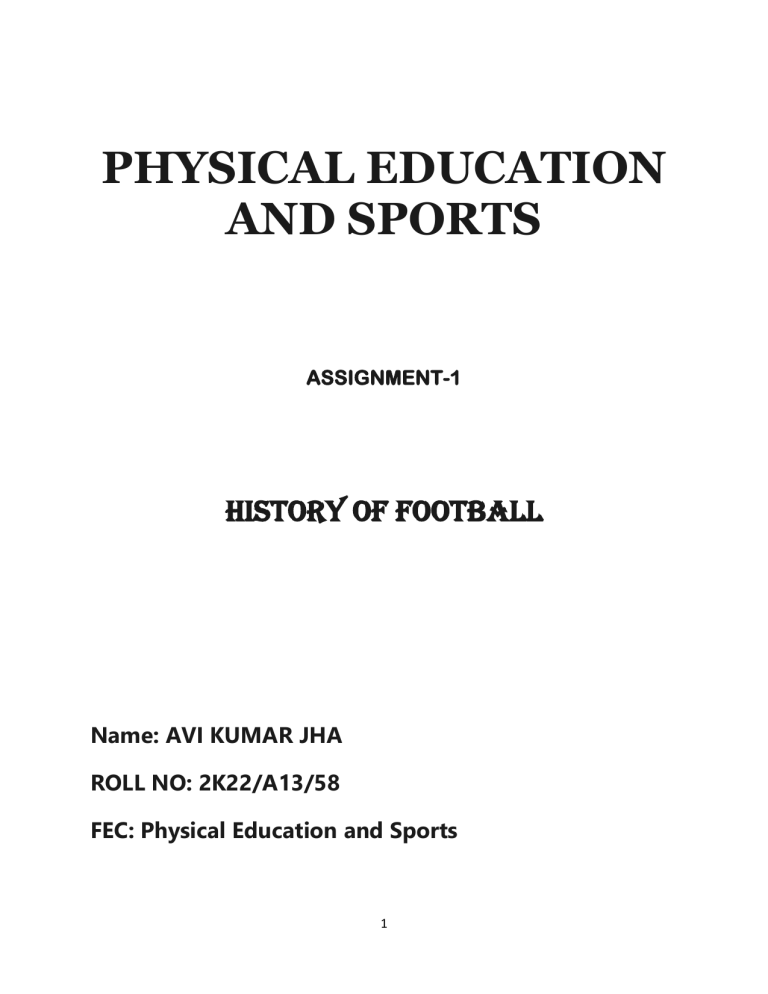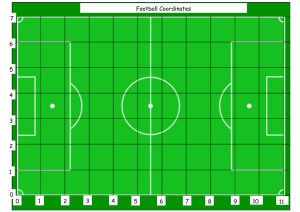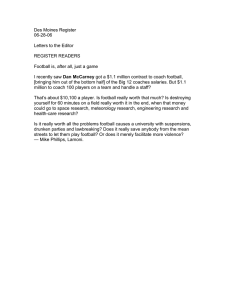
PHYSICAL EDUCATION AND SPORTS ASSIGNMENT-1 History of Football Name: AVI KUMAR JHA ROLL NO: 2K22/A13/58 FEC: Physical Education and Sports 1 Football, also called association football or soccer, game in which two teams of 11 players, using any part of their bodies except their hands and arms, try to maneuver the ball into the opposing team’s goal. Only the goalkeeper is permitted to handle the ball and may do so only within the penalty area surrounding the goal. The team that scores more goals wins. Football is the world’s most popular ball game in numbers of participants and spectators. Simple in its principal rules and essential equipment, the sport can be played almost anywhere, from official football playing fields (pitches) to gymnasiums, streets, school playgrounds, parks, or beaches. Football’s governing body, the Fédération Internationale de Football Association (FIFA), estimated that at the turn of the 21st century there were approximately 250 million football players and over 1.3 billion people “interested” in football; in 2010 a combined television audience of more than 26 billion watched football’s premier tournament, the quadrennial month-long World Cup finals. History The early years Modern football originated in Britain in the 19th century. Since before medieval times, “folk football” games had been played in towns and villages according to local customs and with a minimum of rules. Industrialization and urbanization, which reduced the amount of leisure time and space available to the working class, combined with a history of legal prohibitions against particularly violent and destructive forms of folk football to undermine the game’s status from the early 19th century onward. 2 Each school had its own rules; some allowed limited handling of the ball and others did not. The variance in rules made it difficult for public schoolboys entering university to continue playing except with former schoolmates. As early as 1843 an attempt to standardize and codify the rules of play was made at the University of Cambridge, whose students joined most public schools in 1848 in adopting these “Cambridge rules,” which were further spread by Cambridge graduates who formed football clubs. In 1863 a series of meetings involving clubs from metropolitan London and surrounding counties produced the printed rules of football, which prohibited the carrying of the ball. Thus, the “handling” game of rugby remained outside the newly formed Football Association (FA). Indeed, by 1870 all handling of the ball except by the goalkeeper was prohibited by the FA. 3 The new rules were not universally accepted in Britain, however; many clubs retained their own rules, especially in and around Sheffield. Although this northern English city was the home of the first provincial club to join the FA, in 1867 it also gave birth to the Sheffield Football Association, the forerunner of later county associations. Sheffield and London clubs played two matches against each other in 1866, and a year later a match pitting a club from Middlesex against one from Kent and Surrey was played under the revised rules. In 1871 15 FA clubs accepted an invitation to enter a cup competition and to contribute to the purchase of a trophy. The first known examples of a team game involving a ball, which was made out of a rock, occurred in old Mesoamerican cultures for over 3,000 years ago. It was by the Aztecs called Tchatali, although various versions of the game were spread over large regions. In some ritual occasions, the ball would symbolize the sun and the captain of the losing team would be sacrificed to the gods. A unique feature of the Mesoamerican ball game versions was a bouncing ball made of rubber – no other early culture had access to rubber. Professionalism The development of modern football was closely tied to processes of industrialization and urbanization in Victorian Britain. Most of the new working-class inhabitants of Britain’s industrial towns and cities gradually lost their old bucolic pastimes, such as badger-baiting, and sought fresh forms of collective leisure. From the 1850s onward, industrial workers were increasingly likely to have Saturday afternoons off work, and so many turned to the new game of football to watch or to play. Key urban institutions such as churches, trade unions, and schools organized working-class boys and men into recreational football teams. Rising adult literacy spurred press coverage of organized sports, while transport systems such as the railways or urban trams enabled players and spectators to travel to football games. Average attendance in England rose from 4,600 in 1888 to 7,900 in 1895, rising to 13,200 in 1905 and reaching 23,100 at the outbreak of World War I. Football’s popularity eroded public interest in other sports, notably cricket. 4 Leading clubs, notably those in Lancashire, started charging admission to spectators as early as the 1870s and so, despite the FA’s amateurism rule, were in a position to pay illicit wages to attract highly skilled working-class players, many of them hailing from Scotland. Working-class players and northern English clubs sought a professional system that would provide, in part, some financial reward to cover their “broken time” (time lost from their other work) and the risk of injury. The FA remained staunchly elitist in sustaining a policy of amateurism that protected upper and upper-middle class influence over the game. The issue of professionalism reached a crisis in England in 1884, when the FA expelled two clubs for using professional players. However, the payment of players had become so commonplace by then that the FA had little option but to sanction the practice a year later, despite initial attempts to restrict professionalism to reimbursements for broken time. The consequence was that northern clubs, with their large supporter bases and capacity to attract better players, came to prominence. As the influence of working-class players rose in football, the upper classes took refuge in other sports, notably cricket and rugby union. Professionalism also sparked further modernization of the game through the establishment of the Football League, which allowed the leading dozen teams from the North and Midlands to compete systematically against each other from 1888 onward. A lower, second division was introduced in 1893, and the total number of teams increased to 28. The Irish and Scots formed leagues in 1890. The Southern League began in 1894 but was absorbed by the Football League in 1920. Yet football did not become a major profit-making business during this period. 5 International organization By the early 20th century, football had spread across Europe, but it was in need of international organization. A solution was found in 1904, when representatives from the football associations of Belgium, Denmark, France, the Netherlands, Spain, Sweden, and Switzerland founded the Fédération Internationale de Football Association (FIFA). Although Englishman Daniel Woolfall was elected FIFA president in 1906 and all of the home nations (England, Scotland, Ireland, and Wales) were admitted as members by 1911, British football associations were disdainful of the new body. FIFA members accepted British control over the rules of football via the International Board, which had been established by the home nations in 1882. Nevertheless, in 1920 the British associations resigned their FIFA memberships after failing to persuade other members that Germany, Austria, and Hungary should be expelled following World War I. Other nations again failed to follow their lead, and the British resigned once more in 1928, remaining outside FIFA until 1946. When FIFA established the World Cup championship, British insouciance toward the international game continued. Without membership in FIFA, the British national teams were not invited to the first three competitions (1930, 1934, and 1938). For the next competition, held in 1950, FIFA ruled that the two best finishers in the British home nations tournament would qualify 6 for World Cup play; England won, but Scotland (which finished second) chose not to compete for the World Cup. FIFA membership is open to all national associations. They must accept FIFA’s authority, observe the laws of football, and possess a suitable football infrastructure (i.e., facilities and internal organization). FIFA statutes require members to form continental confederations. The first of these, the Confederación Sudamericana de Fútbol (commonly known as CONMEBOL), was founded in South America in 1916. In 1954 the Union of European Football Associations (UEFA) and the Asian Football Confederation (AFC) were established. Africa’s governing body, the Confédération Africaine de Football (CAF), was founded in 1957. The Confederation of North, Central American and Caribbean Association Football (CONCACAF) followed four years later. The Oceania Football Confederation (OFC) appeared in 1966. These confederations may organize their own club, international, and youth tournaments, elect representatives to FIFA’s Executive Committee, and promote football in their specific continents as they see fit. The First FOOTBALL Clubs Football clubs have existed since the 15th century, but unorganized and without official status. It is therefore hard to decide which the first football club was. Some historians suggest that it was the Foot-Ball Club formed 1824 in Edinburgh. Early clubs were often formed by former school students and the first of this kind was formed in Sheffield in 1855. The oldest among professional football clubs is the English club Notts County that was formed in 1862 and still exists today.An important step for the emergence of teams was the industrialization that led to larger groups of people meeting at places such as factories, pubs and churches. Football teams were established in the larger cities and the new railroads could bring them to other cities. In the beginning, football was dominated by public school teams, but later, teams consisting by workers would make up the majority. Another change was successively taking place when some clubs became willing to pay the best players to join their team. This would be the start of a long period of transition, not without friction, in which the game would develop to a professional level.The motivation behind paying players was 7 not only to win more matches. In the 1880s the interest in the game has moved ahead to a level that tickets were sold to the matches. And finally, in 1885 professional football was legalized and three years later the Football League was established. During the first season, 12 clubs joined the league, but soon more clubs became interested and the competition would consequently expand into more divisions. For a long time, the British teams would be dominant. After some decades, clubs from Prague, Budapest and Sienna would be the primarily contenders to the British dominance.As with many things in history, women were for a long time excluded from participating in games. It was not before the late 19th century that women started to play football. The first official women's game took place in Inverness in 1888. The First Competitions Other milestones were now to follow. Football Association Challenge Cup (FA Cup) became the first important competition when it was run in 1871. The following year a match between two national teams was played for the first time. The match that involved England and Scotland ended 0-0 and was followed by 4,000 people at Hamilton Crescent (the picture shows illustrations from this occasion). 8 Twelve years later, in 1883, the first international tournament took place and included four national teams: England, Ireland, Scotland and Wales. Football was for a long time a British phenomenon, but it gradually spread to other European countries. The first game that took place outside Europe occurred in Argentina in 1867, but it was foreign British workers who were involved and not Argentinean citizens. The Fédération Internationale de Football Association (FIFA) was founded in 1904 and a foundation act was signed by representatives from France, Belgium, Denmark, the Netherlands, Spain, Sweden and Switzerland. England and the other British countries did not join FIFA from the start, they had invented the game and saw no reason to subordinate to an association. Still, they joined in the following year, but would not partake in the World Cup until 1950.Domestic leagues occurred in many countries. The first was, as already mentioned, the English Football League which was established in 1888. The leagues would by time expand by more divisions, which were based on team performance. In 1908 would football for the first time be included as an official sport in the Olympic Games. Until the first FIFA World Cup was played in 1930, the Olympic Games football tournament would rank as the most prestigious on a national level. Women's football was not added until 1996. 9 Football around the world Regional traditions Europe England and Scotland had the first leagues, but clubs sprang up in most European nations in the 1890s and 1900s, enabling these nations to found their own leagues. Many Scottish professional players migrated south to join English clubs, introducing English players and audiences to more-advanced ball-playing skills and to the benefits of teamwork and passing. Up to World War II, the British continued to influence football’s development through regular club tours overseas and the Continental coaching careers of former players. Itinerant Scots were particularly prominent in central Europe. The interwar Danubian school of football emerged from the coaching legacies and expertise of John Madden in Prague and Jimmy Hogan in Austria. The dominant forces in European national football have been Germany, Italy, and, latterly, France; their national teams have won a total of seven World Cups and six European Championships. Success in club football has been built largely on 10 recruitment of the world’s leading players, notably by Italian and Spanish sides. The European Cup competition for national league champions, first played in 1955, was initially dominated by Real Madrid; other regular winners have been AC Milan, Bayern Munich (Germany), Ajax of Amsterdam, and Liverpool FC (England). The UEFA Cup, first contested as the Fairs Cup in 1955–58, has had a wider pool of entrants and winners. UEFA has reinvented the European Cup as the Champions League, allowing the wealthiest clubs freer entry and more matches. In the early 1990s, Belgian player JeanMarc Bosman sued the Belgian Football Association, challenging European football’s traditional rule that all transfers of players (including those without contracts) necessitate an agreement between the clubs in question, usually involving a transfer fee. Bosman had been prevented from joining a new club (US Dunkerque) by his old club (RC Liège). In 1995 the European courts upheld Bosman’s complaint, and at a stroke freed uncontracted European players to move between clubs without transfer fees. The bargaining power of players was strengthened greatly, enabling top stars to multiply their earnings with large salaries and signing bonuses. North and Central America and the Caribbean Football was brought to North America in the 1860s, and by the mid-1880s informal matches had been contested by Canadian and American teams. It soon faced competition from other sports, including variant forms of football. In Canada, Scottish émigrés were particularly prominent in the game’s early development; however, Canadians subsequently turned to ice hockey as their national sport. In the United States, gridiron football emerged early in the 20th century as the most popular sport. But, beyond elite universities and schools, soccer (as the sport is popularly called in the United States) was played widely in some cities with large immigrant populations such as Philadelphia, Chicago, Cleveland (Ohio), and St. Louis (Missouri), as well as New York City and Los Angeles after Hispanic migrations. The U.S. Soccer Federation formed in 1913, affiliated with FIFA, and sponsored competitions. Between the world wars, the United States attracted scores of European emigrants who played football for local teams sometimes sponsored by companies. 11 North American leagues and tournaments saw an infusion of professional players in 1967, beginning with the wholesale importation of foreign teams to represent American cities. The North American Soccer League (NASL) formed a year later and struggled until the New York Cosmos signed the Brazilian superstar Pelé in 1975. Other aging international stars soon followed, and crowds grew to European proportions, but a regular fan base remained elusive, and NASL folded in 1985. South America Football first came to South America in the 19th century through the port of Buenos Aires, Argentina, where European sailors played the game. Members of the British community there formed the first club, the Buenos Aires Football Club (FC), in 1867; about the same time, British railway workers started another club, in the town of Rosario, Argentina. The first Argentinian league championship was played in 1893, but most of the players belonged to the British community, a pattern that continued until the early 20th century. Brazil is believed to be the second South American country where the game was established. Charles Miller, a leading player in England, came to Brazil in 1894 and introduced football in São Paulo; that city’s athletic club was the first to take up the sport. Soon local people across South America began taking up and following the sport in ever greater numbers. Boys, mostly from poorer backgrounds, played from an early age, with passion, on vacant land and streets. Clubs and players gained popularity, and professionalism entered the sport in most countries around the 1930s—although many players had been paid secretly before then by their clubs. The exodus of South American players to European clubs that paid higher salaries began after the 1930 World Cup and has steadily increased. 12 Soon local people across South America began taking up and following the sport in ever greater numbers. Boys, mostly from poorer backgrounds, played from an early age, with passion, on vacant land and streets. Clubs and players gained popularity, and professionalism entered the sport in most countries around the 1930s—although many players had been paid secretly before then by their clubs. The exodus of South American players to European clubs that paid higher salaries began after the 1930 World Cup and has steadily increased. Africa European sailors, soldiers, traders, engineers, and missionaries brought football with them to Africa in the second half of the 19th century. The first documented match took place in Cape Town in 1862, after which the game spread rapidly throughout the continent, particularly in the British colonies and in societies with vibrant indigenous athletic traditions. During the interwar period, African men in cities and towns, railroad workers, and students organized clubs, associations, and regional competitions. Teams from Algeria, Morocco, and Tunisia competed in the North African championship, established in 1919, and vied for the North African Cup, introduced in 1930. South of the Sahara, Kenya and Uganda first played for the Gossage Trophy in 1924, and the Darugar Cup was established on the island of Zanzibar. In the mining centre of Élisabethville (now Lubumbashi, Congo) a football league for Africans was begun in 1925. In South Africa the game was very popular by the early 1930s, though it was organized in racially segregated national associations for whites, Africans, Coloureds (persons of mixed race), and Indians. In the colonies of British West Africa, the Gold Coast (now Ghana) launched its first football association in 1922, with Nigeria’s southern capital of Lagos following suit in 1931. Enterprising clubs and leagues developed across French West Africa in the 1930s, especially in Senegal and Côte d’Ivoire. Moroccan forward Larbi Ben Barek became the first African professional in Europe, playing for Olympique de Marseille and the French national team in 1938. With colonialism’s hold on Africa slipping away, the Confédération Africaine de Football (CAF) was established in February 1957 in Khartoum, Sudan, with the first African Cup of Nations tournament also played at that time. Independent African states encouraged football as a means of forging a national identity and generating international recognition. 13 Asia and Oceania Football quickly entered Asia and Oceania in the latter half of the 19th century, but, unlike in Europe, it failed to become a unifying national sport. In Australia it could not dislodge the winter games of Australian rules football (codified before soccer) and rugby. British immigrants to Australia did relatively little to develop football locally. Because southern European immigrants were more committed to founding clubs and tournaments, football became defined as an “ethnic game.” As a result, teams from Melbourne and Sydney with distinctive Mediterranean connections were the most prominent members of the National Soccer League (NSL) when it started in 1977. The league has widened its scope, however, to include a highly successful Perth side, plus a Brisbane club and even one from Auckland, New Zealand. The NSL collapsed in 2004, but a new league, known as the A-League, emerged the next year. At the turn of the 21st century, football became increasingly important in Asian societies. In Iran, national team football matches became opportunities for many to express their reformist political views as well as for broad public celebration. The Iraqi men’s team’s fourth-place finish at the 2004 Olympic Games in Athens struck a chord of hope for their war-torn homeland. The Asian game is organized by the Asian Football Confederation, comprising 46 members in 2011 and stretching geographically from Lebanon in the Middle East to Guam in the western Pacific Ocean. The Asian Cup for national teams has been held quadrennially since 1956; Iran, Saudi Arabia, and Japan have dominated, with South Korea a regular runner-up. These countries have also produced the most frequent winners of the annual Asian Club Championship, first contested in 1967. 14 Equipment and field of play The object of football is to maneuver the ball into the opposing team’s goal, using any part of the body except the hands and arms. The side scoring more goals wins. The ball is round, covered with leather or some other suitable material, and inflated; it must be 27–27.5 inches (68–70 cm) in circumference and 14.5–16 ounces (410–450 grams) in weight. A game lasts 90 minutes and is divided into halves; the halftime interval lasts 15 minutes, during which the teams change ends. Additional time may be added by the referee to compensate for stoppages in play (for example, player injuries). If neither side wins, and if a victor must be established, “extra-time” is played, and then, if required, a series of penalty kicks may be taken. The penalty area, a rectangular area in front of the goal, is 44 yards (40.2 metres) wide and extends 18 yards (16.5 metres) into the field. The goal is a frame, backed by a net, measuring 8 yards (7.3 metres) wide and 8 feet (2.4 metres) high. The playing field (pitch) should be 100–130 yards (90–120 metres) long and 50–100 yards (45–90 metres) wide; for international matches, it must be 110–120 yards long and 70– 80 yards wide. Women, children, and mature players may play a shorter game on a smaller field. The game is controlled by a referee, who is also the timekeeper, and two assistants who patrol the touchlines, or sidelines, signaling when the ball goes out of play and when players are offside. Players wear jerseys with numbers, shorts, and socks that designate the team for whom they are playing. Shoes and shin guards must be worn. The two teams must wear 15 identifiably different uniforms, and goalkeepers must be distinguishable from all players and match officials. Fouls Free kicks are awarded for fouls or violations of rules; when a free kick is taken, all players of the offending side must be 10 yards (9 metres) from the ball. Free kicks may be either direct (from which a goal may be scored), for more serious fouls, or indirect (from which a goal cannot be scored), for lesser violations. Penalty kicks, introduced in 1891, are awarded for more serious fouls committed inside the area. The penalty kick is a direct free kick awarded to the attacking side and is taken from a spot 12 yards (11 metres) from goal, with all players other than the defending goalkeeper and the kicker outside the penalty area. Since 1970, players guilty of a serious foul are given a yellow caution card; a second caution earns a red card and ejection from the game. Players may also be sent off directly for particularly serious fouls, such as violent conduct. 16



